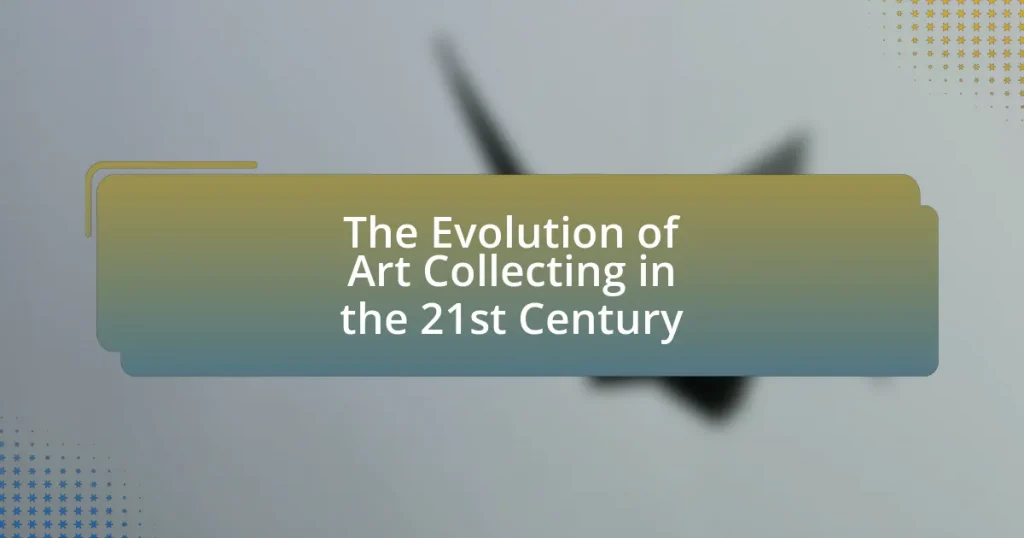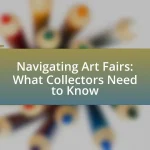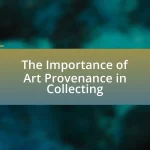The article examines the evolution of art collecting in the 21st century, highlighting the impact of digital platforms, technology, and changing demographics on the art market. It discusses how the definition of art collecting has broadened to include diverse mediums, such as digital art and NFTs, and emphasizes the increasing accessibility of art through online galleries. Key trends include a focus on inclusivity, social issues, and the influence of younger collectors who prioritize contemporary and diverse artists. The article also addresses challenges faced by collectors, such as market volatility and authenticity verification, while outlining best practices for building a meaningful and valuable collection.
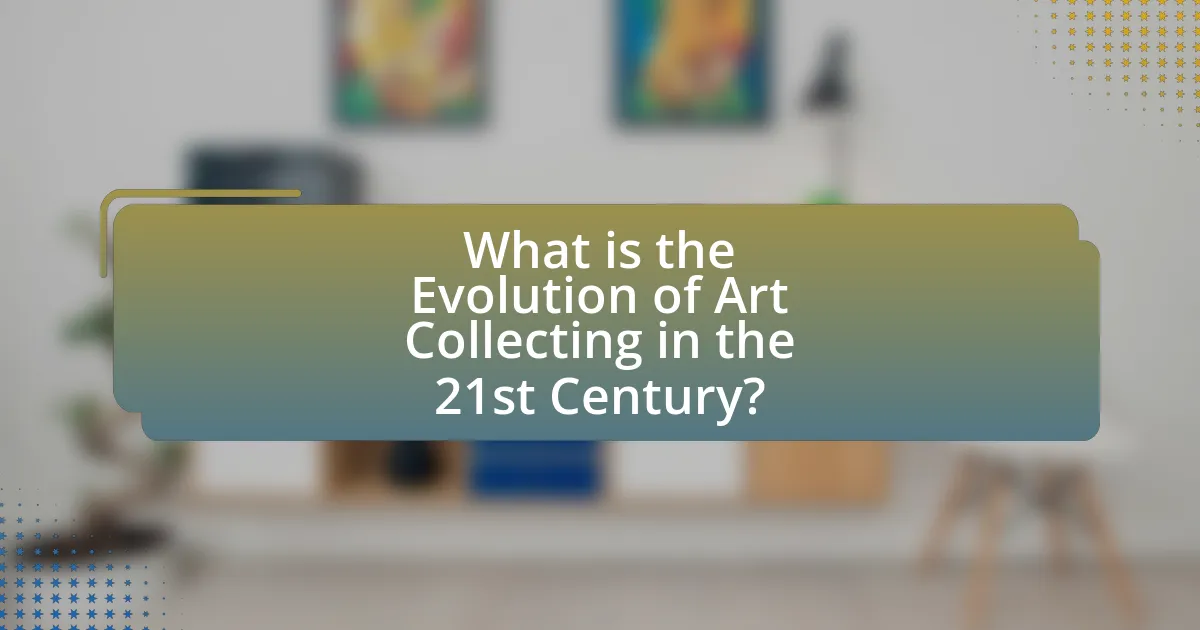
What is the Evolution of Art Collecting in the 21st Century?
The evolution of art collecting in the 21st century is characterized by the rise of digital platforms, increased accessibility to diverse art forms, and the growing influence of technology on the art market. Digital platforms like online galleries and auction houses have democratized access to art, allowing collectors to discover and purchase works from around the world without geographical limitations. Additionally, the emergence of NFTs (non-fungible tokens) has transformed the way art is bought and sold, creating new avenues for artists and collectors alike. According to a report by Art Basel and UBS, the global art market reached an estimated value of $65.1 billion in 2021, highlighting the significant growth and diversification of art collecting practices in this century.
How has the definition of art collecting changed in recent years?
The definition of art collecting has evolved to encompass a broader range of mediums and accessibility, reflecting changes in technology and cultural values. Traditionally, art collecting focused on physical artworks, primarily paintings and sculptures, often by established artists. In recent years, the rise of digital art, including NFTs (non-fungible tokens), has expanded the definition to include virtual and digital assets, allowing collectors to engage with art in new ways. Additionally, the democratization of art through online platforms has made collecting more accessible to a wider audience, shifting the perception from exclusive ownership to community engagement and investment. This shift is evidenced by the increasing number of online art fairs and platforms that cater to diverse collectors, highlighting a more inclusive approach to art collecting.
What factors have influenced the shift in art collecting practices?
The shift in art collecting practices has been influenced by technological advancements, changing demographics, and evolving market dynamics. Technological advancements, particularly the rise of online platforms and digital art, have made art more accessible to a broader audience, allowing collectors to discover and purchase works from anywhere in the world. Changing demographics, including the influx of younger collectors who prioritize contemporary and diverse artists, have shifted the focus of collections. Additionally, evolving market dynamics, such as the increasing importance of art as an investment and the impact of global economic conditions, have further transformed how art is collected. For instance, a report by Art Basel and UBS in 2021 highlighted that online sales in the art market reached $12.4 billion, reflecting the significant role of digital platforms in contemporary art collecting.
How do contemporary collectors differ from those in previous decades?
Contemporary collectors differ from those in previous decades primarily through their increased use of technology and social media to discover, purchase, and share art. Unlike earlier collectors who relied heavily on galleries and auctions, modern collectors utilize online platforms and digital marketplaces, enabling them to access a broader range of artworks and artists globally. According to a 2021 report by Art Basel and UBS, 70% of collectors under 40 years old purchased art online, highlighting a significant shift in buying behavior compared to previous generations. Additionally, contemporary collectors often prioritize diversity and inclusivity in their collections, reflecting broader societal changes and a growing awareness of underrepresented artists. This evolution in collecting practices illustrates how contemporary collectors are reshaping the art market landscape.
Why is understanding the evolution of art collecting important?
Understanding the evolution of art collecting is important because it reveals how cultural, economic, and technological changes influence art valuation and ownership. The historical context shows that art collecting has shifted from aristocratic patronage to a more democratized practice, reflecting broader societal changes. For instance, the rise of online platforms has made art more accessible, allowing a diverse range of collectors to participate in the market. This evolution impacts not only the art market dynamics but also the preservation and appreciation of cultural heritage, as seen in the increasing emphasis on inclusivity and representation in contemporary collections.
What insights can we gain about cultural trends through art collecting?
Art collecting reveals significant insights into cultural trends by reflecting societal values, economic conditions, and aesthetic preferences. For instance, the rise of digital art and NFTs in the 21st century indicates a shift towards technology-driven creativity and a growing acceptance of virtual ownership, highlighting the influence of the digital age on cultural consumption. Additionally, the increasing focus on diversity and representation in art collections showcases a broader societal push for inclusivity and recognition of marginalized voices, as seen in the growing market for works by artists from underrepresented backgrounds. This evolution in art collecting not only mirrors current cultural dialogues but also shapes future artistic directions and community engagement.
How does art collecting reflect societal values and priorities?
Art collecting reflects societal values and priorities by serving as a mirror of cultural, economic, and social trends. For instance, the rise of contemporary art collecting in the 21st century indicates a shift towards valuing diversity and inclusivity, as collectors increasingly seek works from underrepresented artists. This trend is evidenced by the significant increase in auction sales of works by female and minority artists, which rose by 50% from 2018 to 2021, highlighting a growing recognition of their contributions to the art world. Additionally, the focus on sustainability and social issues in art reflects broader societal concerns, with many collectors prioritizing works that address climate change or social justice, thus aligning their collections with their ethical values.
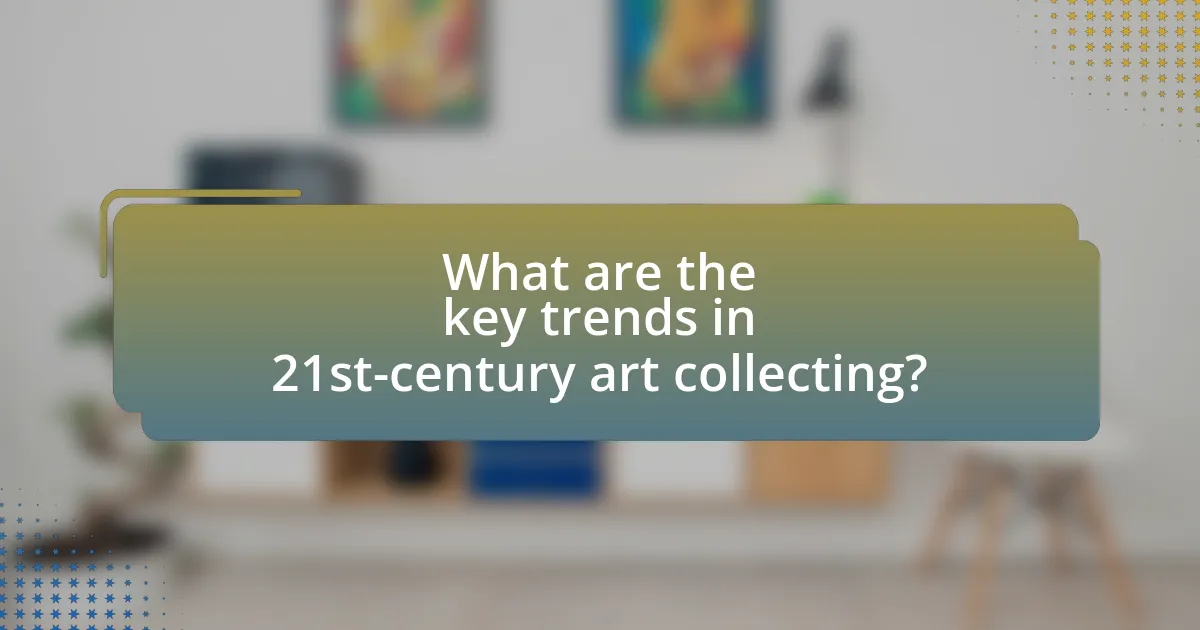
What are the key trends in 21st-century art collecting?
Key trends in 21st-century art collecting include the rise of digital art, increased accessibility through online platforms, and a focus on diversity and social issues. Digital art, particularly NFTs, has transformed the market, allowing artists to reach global audiences and collectors to invest in unique digital assets. Online platforms like Artsy and Saatchi Art have democratized access to art, enabling collectors to discover and purchase works from emerging artists worldwide. Additionally, there is a growing emphasis on collecting art that reflects social justice, environmental concerns, and cultural diversity, as collectors seek to support artists whose work addresses these critical issues. These trends indicate a shift towards a more inclusive and technologically integrated art market.
How has technology impacted art collecting?
Technology has significantly transformed art collecting by enhancing accessibility, facilitating online transactions, and enabling digital art forms. Online platforms like Artsy and Saatchi Art allow collectors to browse and purchase artworks from around the world, breaking geographical barriers. Additionally, blockchain technology has introduced non-fungible tokens (NFTs), which provide a secure method for buying and selling digital art, thus expanding the definition of art ownership. According to a report by Deloitte, the global art market reached $65 billion in 2021, with a notable increase in online sales, which accounted for 25% of the total market. This shift illustrates how technology has not only broadened the market but also changed the way collectors engage with art.
What role do online platforms play in modern art transactions?
Online platforms serve as crucial intermediaries in modern art transactions by facilitating access, visibility, and sales for artists and collectors. These platforms enable artists to showcase their work to a global audience, breaking geographical barriers that traditionally limited art sales. For instance, platforms like Saatchi Art and Artsy have reported significant increases in sales volume, with Saatchi Art noting a 300% growth in sales since its inception. Additionally, online platforms often provide tools for secure transactions and authentication, enhancing buyer confidence. The rise of digital art and NFTs has further solidified the role of online platforms, allowing for innovative forms of ownership and investment in art.
How has social media influenced the visibility of artists and collectors?
Social media has significantly enhanced the visibility of artists and collectors by providing platforms for direct engagement and exposure to global audiences. Artists can showcase their work to millions without the need for traditional galleries, while collectors can discover and connect with emerging talents through platforms like Instagram and Pinterest. For instance, a study by Art Basel and UBS in 2021 indicated that 70% of collectors use social media to discover new artists, demonstrating its pivotal role in the art market. This shift has democratized access to art, allowing diverse voices to gain recognition and fostering a more inclusive art community.
What demographic shifts are occurring in art collecting?
Demographic shifts in art collecting indicate a growing trend of younger collectors, particularly millennials and Gen Z, entering the market. According to a 2021 report by Art Basel and UBS, 63% of new buyers in the art market are under the age of 40, reflecting a significant change from previous decades when older generations dominated. Additionally, there is an increasing diversity among collectors, with more women and individuals from various ethnic backgrounds participating in art acquisition, as highlighted by the 2020 Hiscox Online Art Trade Report, which noted that female collectors accounted for 52% of online art buyers. These shifts are reshaping the landscape of art collecting, making it more inclusive and accessible.
How are younger generations approaching art collecting differently?
Younger generations are approaching art collecting with a focus on digital platforms and inclusivity. Unlike previous generations, they prioritize accessibility and diversity in their collections, often utilizing online marketplaces and social media to discover and purchase art. This shift is evidenced by the rise of platforms like Artsy and Saatchi Art, which cater to a broader audience and allow for easier access to a variety of artists and styles. Additionally, younger collectors are more inclined to support emerging artists and prioritize artworks that reflect social issues, as indicated by surveys showing that 70% of millennial collectors value art that aligns with their personal beliefs and values.
What impact does globalization have on art collectors’ preferences?
Globalization significantly influences art collectors’ preferences by broadening their access to diverse art forms and cultural expressions. As international markets become more interconnected, collectors are increasingly exposed to artworks from various regions, leading to a greater appreciation for non-Western art and contemporary global movements. For instance, the rise of online platforms and international art fairs has facilitated the discovery of artists from different backgrounds, allowing collectors to diversify their collections beyond traditional Western art. This shift is evidenced by the growing interest in African, Asian, and Latin American artists, which reflects a more inclusive understanding of art in the global context.
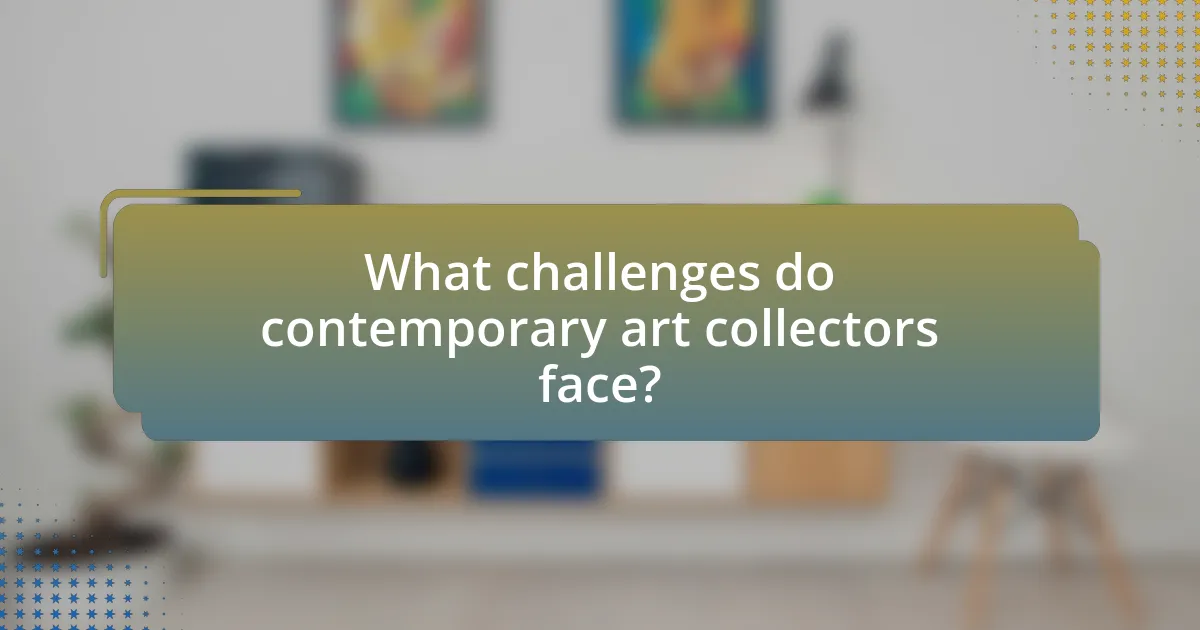
What challenges do contemporary art collectors face?
Contemporary art collectors face several challenges, including market volatility, authenticity verification, and the increasing complexity of art valuation. Market volatility can lead to fluctuating prices, making it difficult for collectors to determine the right time to buy or sell. Authenticity verification is crucial, as the rise of forgeries and misattributed works complicates the purchasing process; according to a report by the Art Loss Register, around 20% of artworks in the market may be misattributed or forged. Additionally, the increasing complexity of art valuation, influenced by factors such as artist reputation and market trends, requires collectors to stay informed and often rely on expert appraisals, which can be costly and time-consuming.
How do economic factors affect art collecting today?
Economic factors significantly influence art collecting today by determining the financial capacity of collectors and shaping market trends. The rise of high-net-worth individuals, particularly in emerging markets, has increased demand for art, driving prices upward. According to the 2021 Art Basel and UBS Global Art Market Report, the global art market reached $65.1 billion in sales, reflecting a recovery from the pandemic and highlighting the impact of economic conditions on collector behavior. Additionally, fluctuations in disposable income and investment trends affect collectors’ willingness to purchase art, as seen in the growing interest in art as an alternative investment. This economic landscape shapes not only the types of art being collected but also the platforms through which art is bought and sold, such as online auctions and galleries.
What are the implications of market volatility for collectors?
Market volatility significantly impacts collectors by influencing the value and liquidity of their assets. When market conditions fluctuate, the prices of collectibles, including art, can experience sharp increases or decreases, affecting the potential return on investment for collectors. For instance, during economic downturns, demand for luxury items often declines, leading to lower prices and making it challenging for collectors to sell their pieces at desired values. Conversely, in a booming market, prices may rise rapidly, creating opportunities for profit. Historical data shows that during the 2008 financial crisis, the art market saw a decline of approximately 30% in value, illustrating how external economic factors can directly affect collectors’ portfolios. Thus, understanding market volatility is crucial for collectors to make informed decisions regarding buying, holding, or selling their collections.
How do collectors navigate authenticity and provenance issues?
Collectors navigate authenticity and provenance issues by employing a combination of expert appraisals, documentation verification, and technological tools. Expert appraisals involve consulting specialists who can authenticate artworks based on their knowledge of artists, styles, and historical context. Documentation verification includes examining certificates of authenticity, previous ownership records, and auction house provenance, which provide a traceable history of the artwork. Additionally, collectors increasingly utilize technologies such as blockchain to create immutable records of provenance, ensuring transparency and trust in the ownership history. These methods collectively enhance the reliability of art transactions and mitigate the risks associated with counterfeit works.
What ethical considerations are involved in modern art collecting?
Ethical considerations in modern art collecting include provenance, cultural appropriation, and the impact of market dynamics on artists and communities. Provenance ensures that artworks are acquired legally and ethically, preventing the support of illicit trade or stolen art. Cultural appropriation raises concerns when collectors exploit cultural artifacts without proper acknowledgment or respect for their origins, potentially harming the communities from which these works originate. Additionally, the art market’s influence can lead to the commodification of art, prioritizing profit over artistic integrity and the welfare of artists, particularly those from marginalized backgrounds. These factors highlight the need for collectors to engage in responsible practices that respect both the art and its cultural significance.
How do collectors address issues of cultural appropriation?
Collectors address issues of cultural appropriation by prioritizing ethical sourcing and engaging with the communities from which the art originates. They often seek to establish relationships with artists and cultural representatives to ensure that the works are acquired in a manner that respects cultural significance and ownership. For instance, many collectors now participate in dialogues about provenance and the historical context of the artworks, which helps to mitigate the risks of appropriation. This approach is supported by initiatives such as the 2019 “Cultural Appropriation and the Arts” report, which emphasizes the importance of transparency and collaboration in art collecting practices.
What responsibilities do collectors have towards artists and communities?
Collectors have the responsibility to support artists financially and promote their work within communities. By purchasing art, collectors provide essential income to artists, enabling them to continue creating. Additionally, collectors can advocate for artists by sharing their work in exhibitions, social media, and personal networks, thereby increasing visibility and appreciation within the community. This support fosters a vibrant art ecosystem, as evidenced by the rise of community-focused art initiatives and collaborations that enhance local culture and economy.
What best practices can art collectors adopt in the 21st century?
Art collectors in the 21st century should adopt best practices such as leveraging technology for research and acquisition, diversifying their collections, and engaging with the art community through social media and online platforms. Utilizing technology allows collectors to access a broader range of artworks and market trends, enhancing informed decision-making. Diversification mitigates risks associated with market fluctuations, as seen in the rise of contemporary art and digital art forms. Engaging with the art community fosters connections and insights, which can lead to better investment opportunities and a deeper understanding of the art landscape. These practices align with the evolving dynamics of the art market, where accessibility and community engagement are increasingly vital.
How can collectors build a diverse and meaningful collection?
Collectors can build a diverse and meaningful collection by actively seeking out artworks from various cultures, mediums, and historical periods. This approach not only enriches the collection but also fosters a deeper understanding of different artistic expressions. For instance, incorporating pieces from contemporary artists alongside traditional works can create a dialogue between past and present, enhancing the collection’s significance. Additionally, attending art fairs, auctions, and exhibitions allows collectors to discover emerging artists and trends, further diversifying their holdings. Research indicates that collections with a wide range of styles and origins tend to appreciate in value over time, making diversity a strategic choice for collectors.
What strategies can enhance the value and enjoyment of an art collection?
To enhance the value and enjoyment of an art collection, collectors should focus on strategic acquisition, proper documentation, and community engagement. Strategic acquisition involves selecting pieces that not only resonate personally but also have potential for appreciation in value, such as works by emerging artists or those with historical significance. Proper documentation, including provenance and condition reports, increases the collection’s credibility and marketability, as evidenced by the fact that artworks with clear provenance often command higher prices at auction. Community engagement through exhibitions, collaborations, and social media can elevate the visibility of the collection, fostering connections with other collectors and art enthusiasts, which can lead to increased appreciation and value over time.










